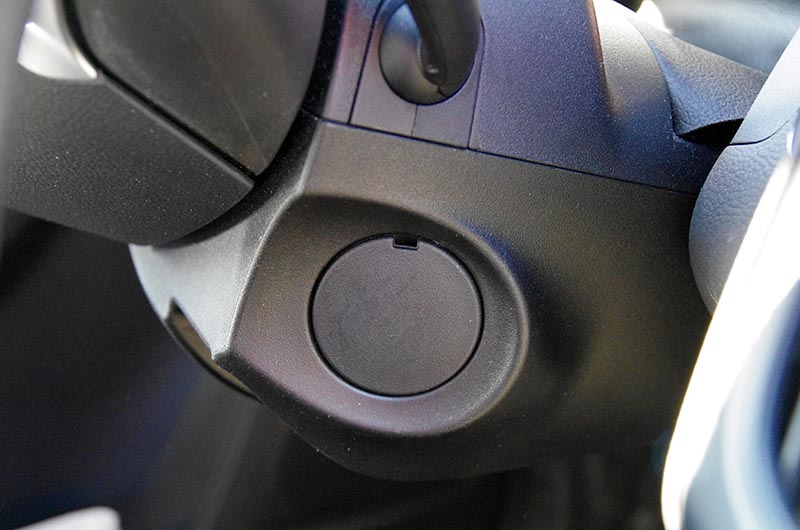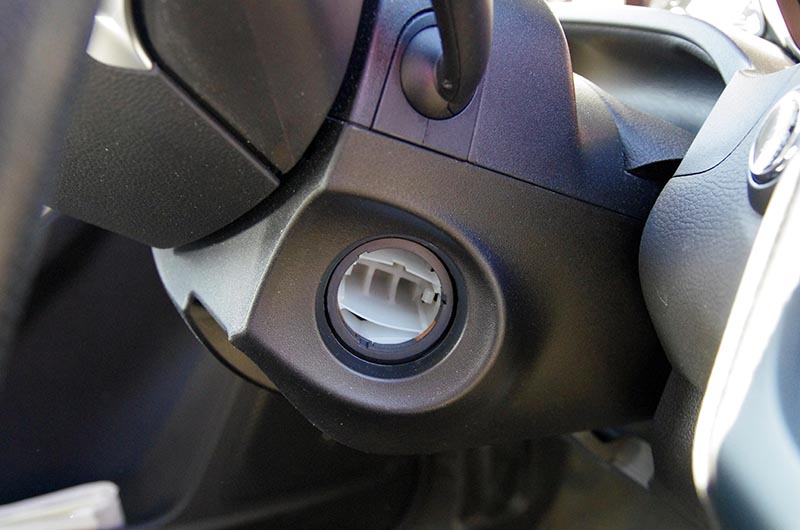Keyless ignition, backup key blade & alt. starting/lock procedures if key fob is dead
Since there were a few recent threads about the keyless ignition, the backup physical key blade in the key fob, and what happens when the battery in the key fob dies I went out earlier tonight to take some pictures and put them in one thread.
First, if the battery in the key fob dies and or the car's battery is dead and you can't use the remote keyless entry to get into the car due to no power for the door locks there should be a physical (mechanical) backup key blade located in the back side of all the Intelligent Access Keys (i.e. key fob). To release the back cover on the key fob to access this backup key you pinch/depress the small ridged tabs on both sides near the bottom of the key fob just above where the key ring attaches while at the same time lifting up on the back "Ford" cover.
![Image]()
![Image]()
![Image]()
![Image]()
![Image]()
NOTE: If you refer to these procedures in owner's manual it is shown under the Intelligent Access Key "Type 1" procedures.
You can then lift out the key blade and use it to open the only physical lock cylinder on the car's exterior which is located on the driver's door handle. If for some reason the car's battery were dead you would use the backup key to lock the driver's door. For the other doors, as shown below, right above the latch assembly is a small slot that you can use the key blade to turn in order to lock the other doors (which don't have a lock cylinder on the door handle).
![Image]()
![Image]()
![Image]()
If the car's battery is good but the key fob battery goes dead or is otherwise damaged, the Focus models with keyless ignition do not have a physical backup lock cylinder and ignition switch located on the steering column. If the key fob's battery is dead and isn't actively able to transmit and talk to the security module in the car there is a backup, passive chip inside the key fob, likely an RFID (radio frequency identification) chip that you can hold up against the cover on the steering column.
A transmitter in the column provides power to the RFID type chip using an inductive coupling but the chip has to be very close to that transmitter in order to receive enough power for the vehicle to be able to talk to it. If you still have problems getting the vehicle to start it appears there is a slot behind the cover with tabs to hold the key fob in place and should be the optimal location for the anti-theft transmitter to be able to power and read the passive security chip in the key fob.
![Image]()
![Image]()
![Image]()
Some people might be concerned that there is no physical lock cylinder/switch assembly behind the cover that could be used with the backup key blade. This really isn't much of an issue, as the ignition switch in most new cars with a conventional key doesn't act on the engine's starter directly. Instead all it does is tell the vehicle's computer that you'd like to crank the engine and the computer then in turn activates the starter relay.
Even with a conventional key, if the built-in anti-theft chip on most new car keys (or key fob on keyless systems) is broken, the anti-theft transmitter/receiver module is defective, the vehicle's computer is inoperative or there is another electrical issue, the car won't start no matter if it has a conventional key or a keyless system. By omitting a physical backup switch it likely allowed Ford to offer the keyless system at a lower price point.
Since there were a few recent threads about the keyless ignition, the backup physical key blade in the key fob, and what happens when the battery in the key fob dies I went out earlier tonight to take some pictures and put them in one thread.
First, if the battery in the key fob dies and or the car's battery is dead and you can't use the remote keyless entry to get into the car due to no power for the door locks there should be a physical (mechanical) backup key blade located in the back side of all the Intelligent Access Keys (i.e. key fob). To release the back cover on the key fob to access this backup key you pinch/depress the small ridged tabs on both sides near the bottom of the key fob just above where the key ring attaches while at the same time lifting up on the back "Ford" cover.





NOTE: If you refer to these procedures in owner's manual it is shown under the Intelligent Access Key "Type 1" procedures.
You can then lift out the key blade and use it to open the only physical lock cylinder on the car's exterior which is located on the driver's door handle. If for some reason the car's battery were dead you would use the backup key to lock the driver's door. For the other doors, as shown below, right above the latch assembly is a small slot that you can use the key blade to turn in order to lock the other doors (which don't have a lock cylinder on the door handle).



If the car's battery is good but the key fob battery goes dead or is otherwise damaged, the Focus models with keyless ignition do not have a physical backup lock cylinder and ignition switch located on the steering column. If the key fob's battery is dead and isn't actively able to transmit and talk to the security module in the car there is a backup, passive chip inside the key fob, likely an RFID (radio frequency identification) chip that you can hold up against the cover on the steering column.
A transmitter in the column provides power to the RFID type chip using an inductive coupling but the chip has to be very close to that transmitter in order to receive enough power for the vehicle to be able to talk to it. If you still have problems getting the vehicle to start it appears there is a slot behind the cover with tabs to hold the key fob in place and should be the optimal location for the anti-theft transmitter to be able to power and read the passive security chip in the key fob.



Some people might be concerned that there is no physical lock cylinder/switch assembly behind the cover that could be used with the backup key blade. This really isn't much of an issue, as the ignition switch in most new cars with a conventional key doesn't act on the engine's starter directly. Instead all it does is tell the vehicle's computer that you'd like to crank the engine and the computer then in turn activates the starter relay.
Even with a conventional key, if the built-in anti-theft chip on most new car keys (or key fob on keyless systems) is broken, the anti-theft transmitter/receiver module is defective, the vehicle's computer is inoperative or there is another electrical issue, the car won't start no matter if it has a conventional key or a keyless system. By omitting a physical backup switch it likely allowed Ford to offer the keyless system at a lower price point.




